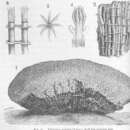Biology
provided by Arkive
The distinctive red pipes contain the coral polyps which, like many other corals, have microscopic algae (zooxanthellae) living within their tissues. Through photosynthesis, these symbiotic algae produce energy-rich molecules that the coral polyps can use as nutrition (2). In return, the coral provides the algae with protection and access to sunlight. In addition, organ pipe corals can capture plankton and organic particles from the water using their feathery tentacles (6).
Conservation
provided by Arkive
Organ pipe corals are listed on Appendix II of the Convention on International Trade in Endangered Species (CITES), which means that trade in this species should be carefully regulated (1). A permit is required to bring organ-pipe coral or objects made from organ-pipe coral such as jewellery, into the 158 countries that have signed the CITES Convention (1). However, with illegal harvesting of this species occurring in the Red Sea, and possibly in other areas, tightening of this legislation may be required, along with an awareness campaign and ready access by custom officials to experts who can identify the smuggled corals (8). Organ pipe corals will form part of the marine community in many marine protected areas (MPAs), which offer coral reefs a degree of protection, and there are many calls from non-governmental organisations for more, and larger, MPAs to ensure the persistence of these unique and fascinating ecosystems (9).
Description
provided by Arkive
Unlike most corals, it is not colourful polyps that make organ pipe corals attractive, but instead, their dark red coloured skeleton (2). The skeleton is composed of thin tubes, or pipes, (hence its common name), which are two millimetres in diameter and cemented together by horizontal plates at intervals of several centimetres (3). Unless the colony has been damaged, a mass of greenish-brown or grey polyps, each with eight tentacles, obscures the skeleton (2) (4). These colonies can form mounds up to 50 centimetres in diameter and may dominate large patches of reef (3). There are at least two species, only one of which is named; Tubipora musica (2). The structure of the tentacles of different colonies of T. musica varies greatly; some have broad feather-like pinnae (tiny projections) down the sides of the tentacles, whilst others have no pinnae at all (2).
Habitat
provided by Arkive
Organ pipe corals are restricted to shallow water, and tend to be found in sheltered areas (5). It is a common species on reef slopes, but inconspicuous (4).
Range
provided by Arkive
Occurs throughout the west Pacific, to the south of Japan, west to Africa's east coast, and throughout the Red Sea (4).
Status
provided by Arkive
Listed on Appendix II of CITES (1).
Threats
provided by Arkive
The permanently coloured skeleton of organ pipe corals makes it an attractive material for ornaments and jewellery (4). It is also crushed and sold in spice shops in countries like Yemen (7), and is a popular species in aquariums as it is easy to maintain and fairly tolerant of aquarium conditions (8). As a result, organ pipe corals are one of the 15 most traded genera of corals (7), and it is under considerable pressure from over-harvesting (8). Whilst trade in this species should be regulated under the Convention on International Trade in Endangered Species (CITES) it seems to have suffered from illegal collection, for example, several major collections of organ pipe coral skeletons were caught being smuggled from the Egyptian Red Sea coral reefs (8).
Organ pipe corals also face the many threats that are impacting coral reefs globally. It is estimated that 20 percent of the world's coral reefs have already been effectively destroyed and show no immediate prospects of recovery, and 24 percent of the world's reefs are under imminent risk of collapse due to human pressures. These human impacts include poor land management practices that are releasing more sediment, nutrients and pollutants into the oceans and stressing the fragile reef ecosystem. Over fishing has 'knock-on' effects that results in the increase of macro-algae that can out-compete and smother corals, and fishing using destructive methods physically devastates the reef. A further potential threat is the increase of coral bleaching events, as a result of global climate change (9).
Brief Summary
provided by EOL authors
Tubipora is a genus of octocoral that lives in colonies of soft coral polyps embedded in a matrix, hard calcium carbonate external skeleton with a structure that resembles organ pipes.Some sources recognize a single species in the genus, T. musica (Wikipedia 2014; Catalogue of Life 2014) although others suggest caution stating that in many regions unidentified species may be confused with the commonly identified T. musica (Australian Biological Resources Study 2013).WORMS references five Tubipora species (van Ofwegen 2014).

